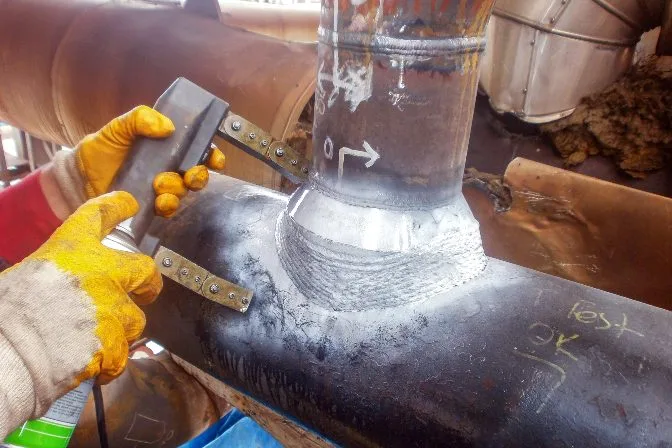How to Guarantee Compliance with Tank Welding Inspection Requirements
A Comprehensive Review of Container Welding Evaluation Requirements and Methodologies for Improved Weld Quality and Efficiency
The relevance of welding examination requirements in the production of tanks can not be overstated, as they serve as the backbone for making sure weld honesty and functional dependability. Numerous examination techniques, consisting of visual evaluations and advanced non-destructive screening techniques, are important in recognizing possible defects that might endanger performance.
Relevance of Welding Evaluation Specifications

Welding assessment requirements include a variety of requirements, consisting of material specs, welding treatments, and qualifications of personnel included in the welding process. By implementing these requirements, organizations can methodically determine and rectify potential flaws, consequently lowering the probability of pricey fixings or disastrous failures. Additionally, rigorous evaluation methods cultivate a culture of liability and accuracy, motivating welders to keep high degrees of workmanship.

Typical Welding Examination Techniques


Ultrasonic Examining (UT) is one more prevalent strategy, making use of high-frequency sound waves to discover internal defects that might not be noticeable externally. This technique is particularly efficient for determining gaps or incorporations within the weld steel. Magnetic Particle Evaluating (MT) is likewise widely utilized, particularly for ferromagnetic products, as it discloses surface and near-surface flaws with the application of electromagnetic fields and ferrous bits.
Additionally, Liquid Penetrant Screening (PT) spots surface-breaking problems by using a penetrant to the weld and after that making use of a designer to draw out the penetrant. Each of these techniques adds to a comprehensive examination method, guaranteeing that welds satisfy the strict top quality requirements needed in storage tank building and construction.
Regulatory Standards and Compliance
Regulatory requirements and compliance are essential elements in ensuring the security and integrity of bonded structures in container building and construction - Tank Welding Inspection. These criteria offer to develop minimum requirements for product homes, welding treatments, and assessment methods, thereby reducing the threat of structural failings and enhancing general performance
Key organizations, such as the American Culture of Mechanical Engineers (ASME) and the American Welding Society (AWS), offer guidelines that are widely taken on in the sector. Compliance with these requirements not just ensures adherence to finest methods but likewise satisfies lawful and legal obligations, protecting the rate of interests of stakeholders.
Regulatory bodies frequently mandate adherence to specific codes, such as ASME Code Area IX for welding qualifications and API 650 for welded tanks. These codes lay out demands for welding techniques, certifications of workers, and testing techniques to validate weld honesty.
Routine audits and evaluations are crucial to preserving conformity, as they aid determine discrepancies from developed standards. more Non-compliance can cause significant fines, task delays, and safety and security hazards. Hence, a robust understanding of regulative criteria and a dedication to conformity are paramount in achieving high-grade and sturdy welded container structures.
Non-Destructive Evaluating Techniques
Just how can websites the honesty of welded structures be ensured without creating damages? Non-destructive testing (NDT) techniques offer a robust service, enabling examiners to assess weld top quality without compromising the product - Tank Welding Inspection. Amongst the most usual NDT methods are ultrasonic testing (UT), radiographic screening (RT), magnetic fragment testing (MT), and dye penetrant screening (PT)
Ultrasonic screening utilizes high-frequency acoustic waves to find inner defects and identify material properties. It supplies precise measurements and is specifically effective for thick products. Radiographic testing involves passing X-rays or gamma rays with the weld, developing images that reveal structural issues such as fractures or spaces. This method is important for analyzing the integrity of complicated welds.
Magnetic particle screening is matched for ferromagnetic products, where electromagnetic fields expose surface and near-surface stoppages. Color penetrant testing makes use of a liquid color to highlight surface-breaking flaws, making it an effective approach for non-porous materials.
Each of these NDT techniques has distinctive benefits, enabling thorough analyses customized to certain materials and welding processes. By applying these strategies, sectors can guarantee the integrity and safety and security of bonded structures, ultimately enhancing overall performance.
Enhancing Weld High Quality Through Assessment
Reliable assessment plays a vital duty in boosting weld top quality, functioning as a vital checkpoint in the construction process. By recognizing prospective issues early, assessments minimize the risk of endangered architectural integrity and ensure compliance with industry criteria. Utilizing a mix of aesthetic exams, non-destructive screening (NDT) methods, and mechanical analyses, assessors can discover issues such as porosity, fractures, and insufficient fusion.
Carrying out a robust evaluation procedure not only boosts the total quality of welds yet additionally promotes a culture of responsibility among welders and makers. Regular training and qualification of assessment personnel make certain that they are outfitted with the needed abilities to recognize and deal with potential problems properly. This proactive method minimizes rework and associated costs, ultimately contributing to forecast performance.
In addition, extensive documentation of assessment searchings for supplies useful insights right into reoccuring problems, facilitating continual renovation in welding practices. By leveraging sophisticated innovations, such as automated ultrasonic screening or digital radiography, weld high quality can be improved through much more precise assessments. Finally, an discover this info here extensive examination procedure is important in attaining top notch welds, guaranteeing security, integrity, and long life in tank fabrication.
Verdict
In conclusion, the execution of rigorous storage tank welding inspection standards and methodologies is necessary for making certain weld integrity and performance. By utilizing a mix of visual examinations, non-destructive screening methods, and adherence to regulatory requirements, organizations can effectively recognize and minimize prospective problems.